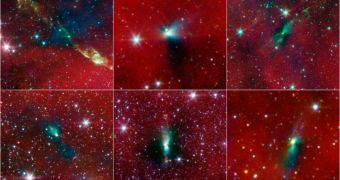For many years, we have been taught to believe that most stars are similar to our Sun, in the sense that they form the sole core of their systems. This picture now appears to be dismantled piece-by-piece by new scientific evidence, which shows that a great number of cosmic fireballs are in fact members of binary systems. In these setups, two stars spin around each other, bound together by the mutual gravitational pulls they exert on each other. The mechanisms through which these binaries form have fascinated and puzzled astronomers for a long time, and now new data comes to clarify the mystery.
One of the main questions related to their development is whether the two components of the binary develop in separate molecular clouds, or if maybe they are born in the same one. Commonly, experts say that systems featuring stars that are fairly distant from each other appeared when two nearby clouds of gas and dust collapsed. When the stars orbit each other at a close distance, researchers believe that a single cloud was the source for both fireballs. But astronomers were in the dark about how a single source could produce two stars.
Experts at the University of Michigan in Ann Arbor decided to investigate the phenomenon, and used the American space agency's Spitzer Space Telescope, which surveys the sky in infrared wavelengths. Data collected with the sensitive observatory determined the existence of asymmetrical gas and dust envelopes around forming stars. These blob-like structures may promote the development of irregularities inside the clouds, which may in turn lead to the emergence of binary systems. Details of the new work appear in a recent issue of the esteemed publication Astrophysical Journal.
University of Michigan in Ann Arbor expert John Tobin, who is also the lead author of the paper, says that “we see asymmetries in the dense material around these proto-stars on scales only a few times larger than the size of the solar system. This means that the disks around them will be fed unevenly, possibly enhancing fragmentation of the disk and triggering binary star formation. We were really surprised by the prevalence of asymmetrical envelope structures. And because we know that most stars are binary, these asymmetries could be indicative of how they form,” Spitzer is managed by experts at the NASA Jet Propulsion Laboratory (JPL) in Pasadena, California.

 14 DAY TRIAL //
14 DAY TRIAL //